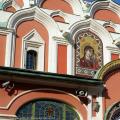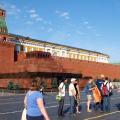Cathedral of the Kazan Icon of the Mother of God. Kazan Cathedral - the Church of the Kazan Mother of God, reborn from the ashes of Red Square
Story
The Cathedral of the Kazan Icon of the Mother of God was erected in memory of the liberation of the Russian state from the Polish-Lithuanian invaders, which took place with the help and intercession of the Mother of God, who showed Her mercy through the miraculous Kazan Icon. The temple was built at the expense of the first king of the Romanov dynasty, Mikhail Feodorovich, and consecrated in 1636. Since its construction, the temple has become one of the most important Moscow churches, its rector occupied one of the first places in the Moscow clergy.
Throughout its history, the cathedral was rebuilt several times - in the 1760s, 1802-05, 1865.
In the 1920s Renovationists served in the cathedral for some time. In 1925-1933. The restoration of the cathedral was carried out under the leadership of the architect P.D. Baranovsky. In 1928, the cathedral's bell tower was demolished. In 1930, the Kazan Cathedral was closed, and in 1936 it was demolished.
The cathedral was restored in 1990-1993. financed by the Moscow City Hall and donations from citizens. The Kazan Cathedral is the first of the Moscow churches completely lost during Soviet times, which was recreated in its original forms. It became possible to recreate the historical appearance of the temple thanks to measurements made by the architect P.D. Baranovsky before the destruction of the temple, and the research of historian S.A. Smirnova. On November 4, 1993, the temple was consecrated.
The Cathedral of the Kazan Icon of the Mother of God is an Orthodox church in front of the mint on the corner of Red Square and Nikolskaya Street in Moscow. This is the first of the Moscow churches completely lost during Soviet times, which was recreated in its original forms.
For the first time, the Cathedral of the Kazan Icon of the Mother of God on Red Square was mentioned in the chronicle for 1625. Prince Pozharsky donated funds for the wooden temple. The icon of the Kazan Mother of God, in whose honor the Cathedral was consecrated, was the most revered at that time.

According to legend, a 9-year-old girl saw the Mother of God three times in a dream, gesturing to her at the ruins of a house. The priest Ermolai, to whom the dream was told, found an icon in the ruins. This happened in Kazan in 1579.

The wooden Cathedral soon burned down in a fire. A stone temple was erected in its place in 1635. The funds were provided by the Tsar himself, Mikhail Fedorovich. The new building of the Church of the Kazan Icon of the Mother of God was made in three colors, each of which had its own meaning.

Gold symbolized the religious purpose of the building, red meant the blood of Christ, as well as fire, which punishes and renews, white - the color of holiness and purity. According to the Byzantine tradition, this color scheme means that the Cathedral was created, first of all, as a military one.

In the Kazan Cathedral of the Icon of the Mother of God on Red Square in Moscow, processions of the cross were periodically held, in which Russian tsars also participated.

Archpriests Avvakum and Neronov, who did not accept Nikon’s church reform, once served in the church. The temple servants who disagreed with Nikon’s innovations were sent into captivity.

The revolution of 1917 became a turning point in the life of the temple. Architect Baranovsky managed to take measurements of the building, which at that time was not only difficult, but also unsafe.

In 1930, the Kazan Cathedral on Red Square was closed, and a canteen appeared within its walls. After 6 years, the shrine was completely dismantled.

On the site of the Church of the Kazan Icon of the Mother of God, a pavilion of the Third International is opened, and for its visitors - a public toilet, which existed on the site of the holy altars until 1990.

Only during this period work began on the restoration of the temple. Baranovsky’s measurements came in handy. The Kazan Cathedral of the Icon of the Mother of God on Red Square ended up in its original place. Finally, the shrine was returned to its purpose. Today it is one of the most famous and most revered temples in the capital.

Fais se que dois adviegne que peut.
The Kazan Cathedral on Red Square is a functioning Orthodox church, built in memory of the liberation of Moscow from Polish invaders by the Russian army led by Dmitry Pozharsky and Kuzma Minin. The history of the Kazan Cathedral is tragic and, at the same time, happy: it was destroyed to the ground, and then reborn like a phoenix from the ashes.
The temple was consecrated in the name of the Kazan Mother of God, with whose icon in 1612 the Russian militia under the leadership of Kuzma Minin and Prince Dmitry Pozharsky set off on a liberation campaign against Moscow occupied by Polish interventionists. In gratitude for the help and intercession of the Kazan Icon of the Mother of God, in 1625 the prince, at his own expense, built a wooden cathedral in the name of this shrine. In 1636, a stone cathedral was erected on the site of the burnt temple, which became one of the main churches in Moscow.
Under Soviet rule, under the leadership of the architect Pyotr Baranovsky, the Kazan Cathedral was restored, but soon, by order of the authorities, it was closed, and a canteen and then a warehouse were placed in the temple building. In 1936, the year of its 300th anniversary, the Kazan Cathedral was demolished to the ground. In its place, a temporary pavilion of the Third International with a fountain was first built, then a summer cafe, and in place of the altar there was a public toilet.
In 1990-1993, with donations from citizens and funds from the Moscow government, the temple was restored according to the design of Baranovsky’s student Oleg Zhurin, and on November 4, 1993, the Kazan Cathedral was consecrated.
The Kazan Cathedral on Red Square is one of the most notable masterpieces of Moscow church architecture, and the Kazan Icon of the Mother of God is one of the most revered in the Russian Orthodox Church.
What is what in the churchAccording to legend, the Mother of God appeared to a ten-year-old girl three times and ordered her to take an icon hidden in the ground. In the indicated place they found an image of the Mother of God wrapped in a piece of cloth. It turned out to be miraculous, and Ivan IV allocated money for the construction of a monastery at the site of the appearance of the image.
The Kazan priest Hermogenes, when transferred to the patriarchal see in Moscow, took the image of the Kazan Mother of God with him. The list remains in Kazan. And in 1721, Peter I transferred the miraculous image to the Kazan Cathedral in St. Petersburg.
The Kazan Church on Red Square in Moscow was built at the expense of Prince Dmitry Pozharsky.
There were cannon barns at this place. But they burned down at the beginning of the 17th century. In 1625, a wooden church appeared, where Dmitry Pozharsky transferred the image of the Kazan Mother of God.
In 1632, the Kazan Church burned down. Then the sovereign allocated bricks from the palace being built for the restoration of the church. And in 1636, on the site of the burnt one, the stone Kazan Cathedral was built in gratitude for the deliverance of Russia from the Polish-Lithuanian invaders and in memory of the fallen Russian soldiers.
In the middle of the 17th century, Archpriest Avvakum served in the Kazan Cathedral on Red Square.
He did not accept Nikon's church reform, which split the Orthodox Church into Nikonians and Old Believers, and led the fight against innovations. The schismatics were excommunicated from the church, exiled to distant monasteries, and imprisoned. Avvakum himself was exiled with his family to Tobolsk, and then to Dauria and Mezen. In 1666 he was anathematized and exiled to the Pustozersky prison. There Avvakum spent 15 years in an earthen prison. Then “The Life of Archpriest Avvakum” appeared. Then the archpriest was burned alive.
April 26, 1755 became a historical day for the Kazan Cathedral - a solemn prayer service was held there in honor of the opening of Moscow University. The cathedral became the parish church of this educational institution. And in 1812, M.I. received the blessing here. Kutuzov, and the cathedral became the first monument to the Patriotic War in Moscow.
But in 1936, the Kazan Cathedral was destroyed, so there is not a single relic in the newly built church.
We can say that the Kazan Cathedral was saved by the architectural historian Pyotr Baranovsky. When the temples were destroyed, he desperately tried to save the ancient structures. Thanks to Baranovsky, the buildings in Kolomenskoye and the cathedral survived. The architect even went on a hunger strike and lay down at the foot of the temple, declaring that he would die with him. As a result, Baranovsky was exiled to Mariinsk, but St. Basil remained standing on Red Square.
The Kazan Cathedral could not be saved. By the beginning of the revolution, the temple had already lost its original appearance. Under the leadership of Baranovsky, it began to be restored in 1927, but in 1930 the reconstruction was frozen. Baranovsky was sent to build the first BAM tracks, and the church was demolished 6 years later. A temporary cafe and public toilet were installed in its place.
In the 1990s, the Kazan Cathedral was restored according to the exact measurements and sketches of Pyotr Baranovsky. And on November 4, 1993, on the day of the Kazan Icon of the Mother of God, the church was opened to visitors. At the same time, the Kazan Cathedral became the first example of the restoration of a temple that was completely destroyed during the Soviet period.
The name “Kazan Cathedral” probably evokes in most travelers associations with the majestic and handsome temple, which is located on the square of the same name in St. Petersburg.
However, in Moscow, on Nikolskaya Street, very close to it there is a cathedral with the same name and an equally rich past. Both churches received their name from the icon of the Kazan Mother of God, with which many events in the history of Russia are connected.
There is such a legend about its acquisition: 27 years after the capture of Kazan by Ivan the Terrible, a fire broke out in the city, as a result of which many houses burned down, including the archer Onuchin. The Mother of God appeared to his little daughter Matrona in a dream and asked him to dig up the icon under the ruins of the house. This request was fulfilled.
And so the miraculous icon appeared to the world, which became in some way the savior of the Russian land. Many lists (copies) were made from it, with one of which the militia of Prince Pozharsky set off to liberate Moscow from the Poles. On November 4 (October 22), 1612, a prayer service was served in front of this icon, and the assault began, ending in triumph.
13 years later, Prince Pozharsky, as a token of gratitude to the miraculous image for the victory granted, built a wooden cathedral at his own expense, which became known as Kazan Cathedral. However, soon another Moscow fire destroyed it, and from 1635 to 1636 the temple was restored using brick as a building material.
The result was a small cathedral. They decorated it with unique kokoshniks, thanks to them it looked elegant and solemn.

The color scheme of the temple (a combination of gold, red and white) was chosen according to Byzantine Orthodox aesthetics. In it, gold symbolizes Divine radiance, red – fire that cleanses from sin, white – purity and holiness. This fully reflected the main meaning of the Kazan Cathedral - the temple of military valor of Orthodox Moscow. The miraculous icon helped drive out the Polish invaders; Peter I prayed in front of it on the eve of the Battle of Poltava, and Kutuzov prayed before the decisive battle with Napoleon. In this cathedral the memory of all soldiers who laid down their lives for the Russian land is sacredly revered.

However, the fate of the temple was truly martyrdom; it was remodeled, demolished and restored. So at the end of the 19th century, under the leadership of the architect N. Kozlovsky, the facade was changed, the kokoshniks were removed, resulting in a standard, in the words of Metropolitan Leonty, “rural church.” This alteration was not to the taste of not only the clergy, but also the parishioners, who raised funds to return the temple to its original appearance. From 1925 to 1930, the architect P. Baranovsky carried out reconstruction, but 6 years later the Kazan Cathedral was demolished, and in its place, first a pavilion in honor of the International was built, and then a public latrine.

In 1990-1993, according to photographs and drawings by P. Baranovsky, the cathedral was restored. The miraculous icon of the Kazan Mother of God returned to it and continues to protect Russia from troubles.
 Kazan Cathedral - the Church of the Kazan Mother of God, reborn from the ashes of Red Square
Kazan Cathedral - the Church of the Kazan Mother of God, reborn from the ashes of Red Square Red Square What is the name of the temple on Red Square
Red Square What is the name of the temple on Red Square How to choose a spinning rod for chub fishing?
How to choose a spinning rod for chub fishing?